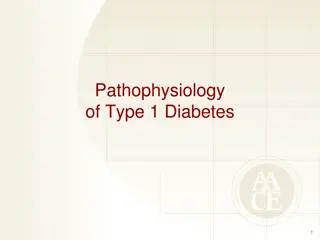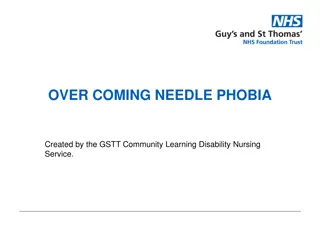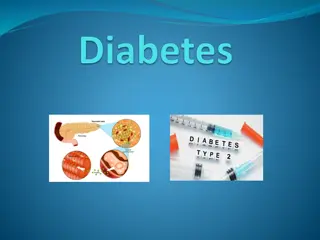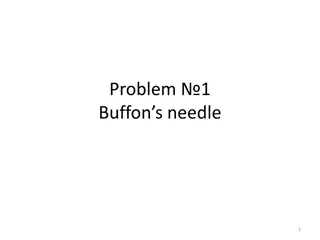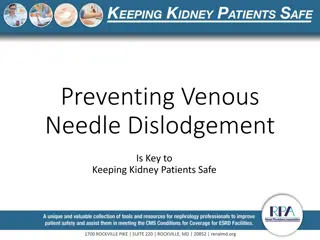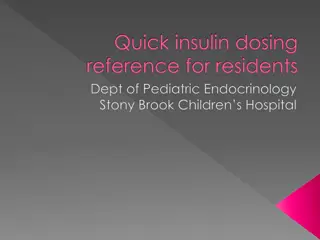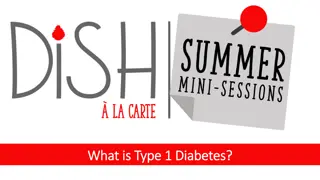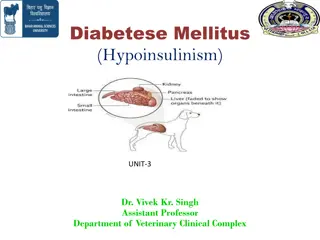New Recommendations for Insulin Injection Technique and Needle Length - Guided by Expert Advice
The new recommendations emphasize using a 4mm needle for insulin injections to reduce the risk of incorrect administration. This needle length is suitable for children, adolescents, thin adults, and even obese patients. The guidelines also highlight the importance of perpendicular insertion of the needle and proper injection techniques for different patient categories. These guidelines aim to enhance the safety and effectiveness of insulin administration.
Uploaded on Sep 15, 2024 | 0 Views
Download Presentation

Please find below an Image/Link to download the presentation.
The content on the website is provided AS IS for your information and personal use only. It may not be sold, licensed, or shared on other websites without obtaining consent from the author.If you encounter any issues during the download, it is possible that the publisher has removed the file from their server.
You are allowed to download the files provided on this website for personal or commercial use, subject to the condition that they are used lawfully. All files are the property of their respective owners.
The content on the website is provided AS IS for your information and personal use only. It may not be sold, licensed, or shared on other websites without obtaining consent from the author.
E N D
Presentation Transcript
New Recommendations for Insulin Injection Technique Guided by Fitter Recommendation (Rome 2015) Final New Recommendations on Needle Length with Pens and Syringes By Dr. Mostafa Abulyazeed ADF 2017
Needle Length The safest pen needle for all patients is 4 mm in length. The 4 mm inserted perpendicularly is long enough to penetrate the skin and enter the SC tissue, with little risk of IM (or ID) injection. ADF 2017
Use of the 4 mm needle is an imperative for all children, adolescents and thin adults. It also must be used in adults of any BMI who inject in the limbs or lateral abdomen. ADF 2017
The 4 mm needle may be used safely and effectively in all obese patients. It is in fact the needle of choice for these patients. ADF 2017
The 4 mm needle should be inserted perpendicular to the skin (at 90 degrees to skin surface), not at an angle. ADF 2017
Young children (6-years old and under) and extremely thin adults (BMI <19) should use the 4 mm needle by lifting a skin fold and injecting into it. All others may inject using the 4 mm needle without lifting a skin fold. ADF 2017
Even if a skin fold is raised, all injections into it with the 4 mm needle must be perpendicular, not at an angle. ADF 2017
Syringe needle The safest currently-available syringe needle for all patients is 6 mm in length. When any syringe needle is used in children, adolescents or slim to normal weight adults, injections should always be into a lifted skin fold. ADF 2017
Use of syringe needles should be prohibited in young children (6-years old and under) and extremely thin adults (BMI <19) even if they use a raised skin fold because of the excessively high risk of IM injections. ADF 2017
Health care authorities and payers should be alerted to the dangers of obligating children to use a 6mm syringe. ADF 2017
An angled injection (at 45) with a 6 mm syringe needle may be used instead of a skin fold in children older than 6 years, because the net penetration of a 45 degree injection with the 6 mm needle is approximately 4 mm. ADF 2017
Avoid indenting the skin during the injection, as the needle may penetrate deeper than intended and enter the muscle. ADF 2017
Children still using the 5mm pen needle should inject using a lifted skin fold. ADF 2017
Children using pen needles >5mm should be shifted to 4 mm needles if possible; and if not, should always use a lifted skin fold. ADF 2017
5 and 6 mm needles require the lifting of a skin fold in thin adults or ones injecting into the limbs; in general the 4 mm needle does not require a skin fold in adults. ADF 2017
Arms should be used for injections with needles 6mm long only if a skin fold has been lifted, which requires injection by a third party. ADF 2017
Patients who must continue using needles 8 mm should always lift a skin fold and/or inject at 45-degrees in order to avoid IM injections. They should be shifted to shorter needles as soon as possible. ADF 2017
If the 4 mm pen needle is not available, obese adults should be using 5 mm needles. ADF 2017
Obese patients with tremors or other disorders which make them unable to hold a 4 mm pen needle in place may need longer needles. ADF 2017
The safest currently-available syringe needle for obese patients is 6 mm in length. ADF 2017
Final New Recommendations on Injections of the Different Insulins Injection sites ADF 2017
Rapid-acting insulin analogues may be given at any of the injection sites, as absorption rates do not appear to be site-specific.
Rapid-acting analogues should not be given IM although studies have shown that absorption rates are similar from fat tissue and resting muscle. Absorption from working muscle has not however been studied. ADF 2017
Pending further studies, patients may inject long-acting insulin analogues in any of the usual injecting sites. ADF 2017
IM injections of long-acting analogues must be strictly avoided due to the risk of severe hypoglycemia. Patients exercising or doing physical work after injecting long-acting analogues should also be warned about hypoglycemia. ADF 2017
IM injection of NPH should be avoided since rapid absorption and serious hypoglycemia can result. ADF 2017
Pending further studies, patients who inject GLP-1 agents should follow the recommendations already established for insulin injections with regards to needle length and site rotation. ADF 2017
GLP-1 agents may be given at any of the usual injection sites as the pharmacokinetics do not appear to be site-specific. ADF 2017
The thigh and especially the buttocks are the preferred injection sites when using NPH as the basal insulin since absorption for this insulin is slowest from these sites; if possible NPH should be given at bedtime rather than at dinner to reduce the risk of nocturnal hypoglycemia. ADF 2017
The abdomen is the preferred site for soluble human insulin (Regular), since absorption of this insulin is fastest there. ADF 2017
The absorption of soluble human insulin in the elderly can be slow and these insulins should not be used when a rapid effect is needed. ADF 2017
The Regular/NPH mix should be given in the abdomen in the morning to increase the speed of absorption of the short-acting insulin in order to cover post-breakfast glycemic excursions. ADF 2017
Any mix containing NPH and given in the evening should be into thigh or buttock as these sites have slower absorption of NPH and this decreases the risk of nocturnal hypoglycemia. ADF 2017
Cloudy insulins (e.g. NPH and pre-mixed insulins) must be gently rolled and/or tipped until the crystals go back into suspension (solution becomes milky white). ~ 20 times ADF 2017
Tipping involves one full flexion and extension of the elbow (counts as 1 time) or rolling the vial or pen a full cycle between the palms (counts as 1 time). ADF 2017
This tipping and/or rolling should be carried out 20 times immediately before every injection with these insulins. ADF 2017
Vigorous shaking should be avoided since this produces bubbles which reduce dose accuracy. ADF 2017










